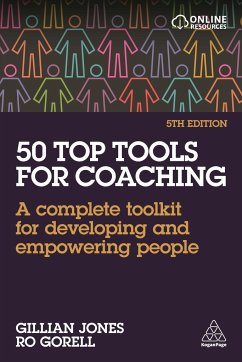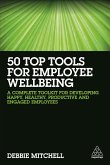Gillian Jones, Ro Gorell
50 Top Tools for Coaching
A Complete Toolkit for Developing and Empowering People
Gillian Jones, Ro Gorell
50 Top Tools for Coaching
A Complete Toolkit for Developing and Empowering People
- Broschiertes Buch
- Merkliste
- Auf die Merkliste
- Bewerten Bewerten
- Teilen
- Produkt teilen
- Produkterinnerung
- Produkterinnerung
Full of exercises, models, checklists and templates, this book covers how to assess the needs of clients, select the right tool for the circumstance and deliver effective coaching with confidence.
A complete resource for both in-house and external coaches, 50 Top Tools for Coaching presents the techniques required for every coaching situation. It focuses on every stage of the coaching process, from setting up and managing the coaching relationship, understanding and resolving conflict, developing client confidence and performance to enhancing leadership styles and coaching during periods of…mehr
Andere Kunden interessierten sich auch für
![50 Top Tools for Employee Wellbeing 50 Top Tools for Employee Wellbeing]() Debbie Mitchell50 Top Tools for Employee Wellbeing51,99 €
Debbie Mitchell50 Top Tools for Employee Wellbeing51,99 €![Mindful Leadership Coaching Mindful Leadership Coaching]() Kenneth A. LoparoMindful Leadership Coaching37,99 €
Kenneth A. LoparoMindful Leadership Coaching37,99 €![50 Years a Keynesian and Other Essays 50 Years a Keynesian and Other Essays]() G. Harcourt50 Years a Keynesian and Other Essays125,99 €
G. Harcourt50 Years a Keynesian and Other Essays125,99 €![Mit 50 schon zum alten Eisen? Mit 50 schon zum alten Eisen?]() Günther SpecknerMit 50 schon zum alten Eisen?54,99 €
Günther SpecknerMit 50 schon zum alten Eisen?54,99 €![Informationsverhalten der Zielgruppe 50 plus Informationsverhalten der Zielgruppe 50 plus]() Adnan CivginInformationsverhalten der Zielgruppe 50 plus49,00 €
Adnan CivginInformationsverhalten der Zielgruppe 50 plus49,00 €![50 Milliarden Euro für Aufstocker 50 Milliarden Euro für Aufstocker]() R. Reuter50 Milliarden Euro für Aufstocker9,99 €
R. Reuter50 Milliarden Euro für Aufstocker9,99 €![50 Wege im Management Erfolg zu verhindern 50 Wege im Management Erfolg zu verhindern]() Arno Ritter50 Wege im Management Erfolg zu verhindern18,99 €
Arno Ritter50 Wege im Management Erfolg zu verhindern18,99 €-
-
-
Full of exercises, models, checklists and templates, this book covers how to assess the needs of clients, select the right tool for the circumstance and deliver effective coaching with confidence.
A complete resource for both in-house and external coaches, 50 Top Tools for Coaching presents the techniques required for every coaching situation. It focuses on every stage of the coaching process, from setting up and managing the coaching relationship, understanding and resolving conflict, developing client confidence and performance to enhancing leadership styles and coaching during periods of change. Supporting hints and tips are found throughout to maximise the effectiveness and impact of the tools.
This fully revised fifth edition of 50 Top Tools for Coaching includes new tools for managers for performance coaching and for building your own coaching practice. It remains an indispensable resource for coaches of all levels of experience and in all remits, as wellas managers and leaders looking to improve performance in their organizations through coaching. Online supporting resources include additional tools, interactive templates and videos of the tools in action demonstrated by the authors.
A complete resource for both in-house and external coaches, 50 Top Tools for Coaching presents the techniques required for every coaching situation. It focuses on every stage of the coaching process, from setting up and managing the coaching relationship, understanding and resolving conflict, developing client confidence and performance to enhancing leadership styles and coaching during periods of change. Supporting hints and tips are found throughout to maximise the effectiveness and impact of the tools.
This fully revised fifth edition of 50 Top Tools for Coaching includes new tools for managers for performance coaching and for building your own coaching practice. It remains an indispensable resource for coaches of all levels of experience and in all remits, as wellas managers and leaders looking to improve performance in their organizations through coaching. Online supporting resources include additional tools, interactive templates and videos of the tools in action demonstrated by the authors.
Produktdetails
- Produktdetails
- Verlag: Kogan Page
- Artikelnr. des Verlages: 13005
- 5. Aufl.
- Seitenzahl: 352
- Erscheinungstermin: 27. April 2021
- Englisch
- Abmessung: 231mm x 155mm x 21mm
- Gewicht: 528g
- ISBN-13: 9781789666557
- ISBN-10: 1789666554
- Artikelnr.: 60073453
- Herstellerkennzeichnung
- Libri GmbH
- Europaallee 1
- 36244 Bad Hersfeld
- gpsr@libri.de
- Verlag: Kogan Page
- Artikelnr. des Verlages: 13005
- 5. Aufl.
- Seitenzahl: 352
- Erscheinungstermin: 27. April 2021
- Englisch
- Abmessung: 231mm x 155mm x 21mm
- Gewicht: 528g
- ISBN-13: 9781789666557
- ISBN-10: 1789666554
- Artikelnr.: 60073453
- Herstellerkennzeichnung
- Libri GmbH
- Europaallee 1
- 36244 Bad Hersfeld
- gpsr@libri.de
Gillian Jones is Managing Director of Emerge, an international development consultancy that specializes in leadership, organizational development and executive coaching. She is a motivational speaker, a Master Executive Coach and a champion for women's development, delivering RISE, the popular empowering women's programme, both in Europe and the Middle East. Ro Gorell is Director at Change Optimised, supporting leaders to navigate organisation-wide transformation through coaching, mentoring and change management solutions. She has extensive experience in both group and individual coaching. An accredited trainer with IC Agile she is an active member of both the Agile and Change Management global communities. Based in Australia, she is the author of Group Coaching and with Gillian Jones the co-author of How to Create a Coaching Culture, also published by Kogan Page. Her latest area of research is coaching self-organizing teams.
- Chapter - 00: Introduction;
- Section - ONE: Setting up the coaching relationship;
- Chapter - 01: The coaching process
- Chapter - 02: Coaching assessment form;
- Chapter - 03: Coaching brief and contracting form;
- Chapter - 04: Coaching self-assessment questionnaire;
- Chapter - 05: Checklist for establishing contract rules;
- Chapter - 06: Action plan;
- Chapter - 07: Coaching evaluation;
- Section - TWO: Foundation tools;
- Chapter - 08: Listening model;
- Chapter - 09: Questioning skills and techniques;
- Chapter - 10: Feedback techniques and examples;
- Chapter - 11: The ORACLE model;
- Chapter - 12: Coffee-break coaching;
- Chapter - 13: Self-coaching;
- Section - THREE: Goal setting;
- Chapter - 14: Creating powerful intentions;
- Chapter - 15: Goal setting;
- Chapter - 16: Breaking down previous goals;
- Chapter - 17: Spatial action planning;
- Chapter - 18: Goal visualization;
- Chapter - 19: Goal visualization script;
- Section - FOUR: Problem resolution;
- Chapter - 20: Logical levels;
- Chapter - 21: Positive problem solving (reframing);
- Chapter - 22: Problem mapping;
- Section - FIVE: Values and beliefs;
- Chapter - 23: Internal conflict negotiation;
- Chapter - 24: Helping individuals reduce stress;
- Chapter - 25: Changing negative thought patterns;
- Chapter - 26: Determining values;
- Chapter - 27: Prioritizing values;
- Chapter - 28: Belief assessment;
- Section - SIX: Confidence strategies;
- Chapter - 29: Reprogramming negative language;
- Chapter - 30: Personal centre of excellence;
- Section - SEVEN: Working effectively with others;
- Chapter - 31: Behavioural conflict resolution;
- Chapter - 32: Analysing and resolving conflict;
- Chapter - 33: 360-degree perspective;
- Section - EIGHT: Personal impact and influence;
- Chapter - 34: Communication skills audit and skills inventory;
- Chapter - 35: 360-degree feedback;
- Section - NINE: Enhancing leadership style;
- Chapter - 36: Team climate inventory;
- Chapter - 37: Improving the delegation process
- Chapter - 38: Planning to delegate;
- Chapter - 39: Prioritizing: paired comparison;
- Chapter - 40: Prioritizing: importance-urgency grid;
- Section - TEN: Planning for the future;
- Chapter - 41:
Chapter
00: Introduction; Section
ONE: Setting up the coaching relationship; Chapter
01: The coaching process Chapter
02: Coaching assessment form; Chapter
03: Coaching brief and contracting form; Chapter
04: Coaching self
assessment questionnaire; Chapter
05: Checklist for establishing contract rules; Chapter
06: Action plan; Chapter
07: Coaching evaluation; Section
TWO: Foundation tools; Chapter
08: Listening model; Chapter
09: Questioning skills and techniques; Chapter
10: Feedback techniques and examples; Chapter
11: The ORACLE model; Chapter
12: Coffee
break coaching; Chapter
13: Self
coaching; Section
THREE: Goal setting; Chapter
14: Creating powerful intentions; Chapter
15: Goal setting; Chapter
16: Breaking down previous goals; Chapter
17: Spatial action planning; Chapter
18: Goal visualization; Chapter
19: Goal visualization script; Section
FOUR: Problem resolution; Chapter
20: Logical levels; Chapter
21: Positive problem solving (reframing); Chapter
22: Problem mapping; Section
FIVE: Values and beliefs; Chapter
23: Internal conflict negotiation; Chapter
24: Helping individuals reduce stress; Chapter
25: Changing negative thought patterns; Chapter
26: Determining values; Chapter
27: Prioritizing values; Chapter
28: Belief assessment; Section
SIX: Confidence strategies; Chapter
29: Reprogramming negative language; Chapter
30: Personal centre of excellence; Section
SEVEN: Working effectively with others; Chapter
31: Behavioural conflict resolution; Chapter
32: Analysing and resolving conflict; Chapter
33: 360
degree perspective; Section
EIGHT: Personal impact and influence; Chapter
34: Communication skills audit and skills inventory; Chapter
35: 360
degree feedback; Section
NINE: Enhancing leadership style; Chapter
36: Team climate inventory; Chapter
37: Improving the delegation process Chapter
38: Planning to delegate; Chapter
39: Prioritizing: paired comparison; Chapter
40: Prioritizing: importance
urgency grid; Section
TEN: Planning for the future; Chapter
41: Life events; Chapter
42: The discovery model; Chapter
43: Ideal work designer; Chapter
44: Managing my career; Section
ELEVEN: Developing women; Chapter
45: Identifying super powers through strengths
based portraits; Chapter
46: Reflected strengths portrait exercise; Chapter
47: Improving confidence by changing beliefs; Chapter
48: Questions to change limiting beliefs (part 1); Chapter
49: Questions to change limiting beliefs (part 2); Chapter
50: Confidence building; Chapter
51: Emotional intelligence through modelling; Chapter
52: Managing upwards; Section
TWELVE: Coaching during change; Chapter
53: Creating a group coaching environment; Chapter
54: Creating tools for group coaching; Chapter
55: Lean change canvas; Chapter
56: Mapping different perspectives; Chapter
57: Hot seat coaching; Section
THIRTEEN: Ten extra tools from our coaches; Chapter
58: Goal setting
ensuring goals are aligned; Chapter
59: Targeting what's important; Chapter
60: Guiding others through the change journey; Chapter
61: SLOBA model for building credibility; Chapter
62: The alignment process; Chapter
63: Accountability review; Chapter
64: Breaking the gridlock; Chapter
65: Building resilience; Chapter
66: Building and using a supportive network; Chapter
67: Establishing a real purpose, meaning and value for client progress; Section
FOURTEEN: A manager's guide to coaching; Chapter
68: Coaching to improve performance; Chapter
69: Coaching to retain talent; Chapter
70: Coaching people who are in conflict; Chapter
71: Coaching upwards; Chapter
72: Coaching for resistance to change: Dealing with negativity; Section
FIFTEEN: Building a coaching practice; Chapter
73: Your value proposition; Chapter
74: Creating coaching packages; Chapter
75: Pricing your coaching services; Chapter
76: Managing your business process; Chapter
77: Systems for delivering your coaching services; Chapter
78: Coach yourself first: A coach's guide to self
reflection (by Mark Bisson); Chapter
79: Tools for supervision (by Mark Bisson)
00: Introduction; Section
ONE: Setting up the coaching relationship; Chapter
01: The coaching process Chapter
02: Coaching assessment form; Chapter
03: Coaching brief and contracting form; Chapter
04: Coaching self
assessment questionnaire; Chapter
05: Checklist for establishing contract rules; Chapter
06: Action plan; Chapter
07: Coaching evaluation; Section
TWO: Foundation tools; Chapter
08: Listening model; Chapter
09: Questioning skills and techniques; Chapter
10: Feedback techniques and examples; Chapter
11: The ORACLE model; Chapter
12: Coffee
break coaching; Chapter
13: Self
coaching; Section
THREE: Goal setting; Chapter
14: Creating powerful intentions; Chapter
15: Goal setting; Chapter
16: Breaking down previous goals; Chapter
17: Spatial action planning; Chapter
18: Goal visualization; Chapter
19: Goal visualization script; Section
FOUR: Problem resolution; Chapter
20: Logical levels; Chapter
21: Positive problem solving (reframing); Chapter
22: Problem mapping; Section
FIVE: Values and beliefs; Chapter
23: Internal conflict negotiation; Chapter
24: Helping individuals reduce stress; Chapter
25: Changing negative thought patterns; Chapter
26: Determining values; Chapter
27: Prioritizing values; Chapter
28: Belief assessment; Section
SIX: Confidence strategies; Chapter
29: Reprogramming negative language; Chapter
30: Personal centre of excellence; Section
SEVEN: Working effectively with others; Chapter
31: Behavioural conflict resolution; Chapter
32: Analysing and resolving conflict; Chapter
33: 360
degree perspective; Section
EIGHT: Personal impact and influence; Chapter
34: Communication skills audit and skills inventory; Chapter
35: 360
degree feedback; Section
NINE: Enhancing leadership style; Chapter
36: Team climate inventory; Chapter
37: Improving the delegation process Chapter
38: Planning to delegate; Chapter
39: Prioritizing: paired comparison; Chapter
40: Prioritizing: importance
urgency grid; Section
TEN: Planning for the future; Chapter
41: Life events; Chapter
42: The discovery model; Chapter
43: Ideal work designer; Chapter
44: Managing my career; Section
ELEVEN: Developing women; Chapter
45: Identifying super powers through strengths
based portraits; Chapter
46: Reflected strengths portrait exercise; Chapter
47: Improving confidence by changing beliefs; Chapter
48: Questions to change limiting beliefs (part 1); Chapter
49: Questions to change limiting beliefs (part 2); Chapter
50: Confidence building; Chapter
51: Emotional intelligence through modelling; Chapter
52: Managing upwards; Section
TWELVE: Coaching during change; Chapter
53: Creating a group coaching environment; Chapter
54: Creating tools for group coaching; Chapter
55: Lean change canvas; Chapter
56: Mapping different perspectives; Chapter
57: Hot seat coaching; Section
THIRTEEN: Ten extra tools from our coaches; Chapter
58: Goal setting
ensuring goals are aligned; Chapter
59: Targeting what's important; Chapter
60: Guiding others through the change journey; Chapter
61: SLOBA model for building credibility; Chapter
62: The alignment process; Chapter
63: Accountability review; Chapter
64: Breaking the gridlock; Chapter
65: Building resilience; Chapter
66: Building and using a supportive network; Chapter
67: Establishing a real purpose, meaning and value for client progress; Section
FOURTEEN: A manager's guide to coaching; Chapter
68: Coaching to improve performance; Chapter
69: Coaching to retain talent; Chapter
70: Coaching people who are in conflict; Chapter
71: Coaching upwards; Chapter
72: Coaching for resistance to change: Dealing with negativity; Section
FIFTEEN: Building a coaching practice; Chapter
73: Your value proposition; Chapter
74: Creating coaching packages; Chapter
75: Pricing your coaching services; Chapter
76: Managing your business process; Chapter
77: Systems for delivering your coaching services; Chapter
78: Coach yourself first: A coach's guide to self
reflection (by Mark Bisson); Chapter
79: Tools for supervision (by Mark Bisson)
- Chapter - 00: Introduction;
- Section - ONE: Setting up the coaching relationship;
- Chapter - 01: The coaching process
- Chapter - 02: Coaching assessment form;
- Chapter - 03: Coaching brief and contracting form;
- Chapter - 04: Coaching self-assessment questionnaire;
- Chapter - 05: Checklist for establishing contract rules;
- Chapter - 06: Action plan;
- Chapter - 07: Coaching evaluation;
- Section - TWO: Foundation tools;
- Chapter - 08: Listening model;
- Chapter - 09: Questioning skills and techniques;
- Chapter - 10: Feedback techniques and examples;
- Chapter - 11: The ORACLE model;
- Chapter - 12: Coffee-break coaching;
- Chapter - 13: Self-coaching;
- Section - THREE: Goal setting;
- Chapter - 14: Creating powerful intentions;
- Chapter - 15: Goal setting;
- Chapter - 16: Breaking down previous goals;
- Chapter - 17: Spatial action planning;
- Chapter - 18: Goal visualization;
- Chapter - 19: Goal visualization script;
- Section - FOUR: Problem resolution;
- Chapter - 20: Logical levels;
- Chapter - 21: Positive problem solving (reframing);
- Chapter - 22: Problem mapping;
- Section - FIVE: Values and beliefs;
- Chapter - 23: Internal conflict negotiation;
- Chapter - 24: Helping individuals reduce stress;
- Chapter - 25: Changing negative thought patterns;
- Chapter - 26: Determining values;
- Chapter - 27: Prioritizing values;
- Chapter - 28: Belief assessment;
- Section - SIX: Confidence strategies;
- Chapter - 29: Reprogramming negative language;
- Chapter - 30: Personal centre of excellence;
- Section - SEVEN: Working effectively with others;
- Chapter - 31: Behavioural conflict resolution;
- Chapter - 32: Analysing and resolving conflict;
- Chapter - 33: 360-degree perspective;
- Section - EIGHT: Personal impact and influence;
- Chapter - 34: Communication skills audit and skills inventory;
- Chapter - 35: 360-degree feedback;
- Section - NINE: Enhancing leadership style;
- Chapter - 36: Team climate inventory;
- Chapter - 37: Improving the delegation process
- Chapter - 38: Planning to delegate;
- Chapter - 39: Prioritizing: paired comparison;
- Chapter - 40: Prioritizing: importance-urgency grid;
- Section - TEN: Planning for the future;
- Chapter - 41:
Chapter
00: Introduction; Section
ONE: Setting up the coaching relationship; Chapter
01: The coaching process Chapter
02: Coaching assessment form; Chapter
03: Coaching brief and contracting form; Chapter
04: Coaching self
assessment questionnaire; Chapter
05: Checklist for establishing contract rules; Chapter
06: Action plan; Chapter
07: Coaching evaluation; Section
TWO: Foundation tools; Chapter
08: Listening model; Chapter
09: Questioning skills and techniques; Chapter
10: Feedback techniques and examples; Chapter
11: The ORACLE model; Chapter
12: Coffee
break coaching; Chapter
13: Self
coaching; Section
THREE: Goal setting; Chapter
14: Creating powerful intentions; Chapter
15: Goal setting; Chapter
16: Breaking down previous goals; Chapter
17: Spatial action planning; Chapter
18: Goal visualization; Chapter
19: Goal visualization script; Section
FOUR: Problem resolution; Chapter
20: Logical levels; Chapter
21: Positive problem solving (reframing); Chapter
22: Problem mapping; Section
FIVE: Values and beliefs; Chapter
23: Internal conflict negotiation; Chapter
24: Helping individuals reduce stress; Chapter
25: Changing negative thought patterns; Chapter
26: Determining values; Chapter
27: Prioritizing values; Chapter
28: Belief assessment; Section
SIX: Confidence strategies; Chapter
29: Reprogramming negative language; Chapter
30: Personal centre of excellence; Section
SEVEN: Working effectively with others; Chapter
31: Behavioural conflict resolution; Chapter
32: Analysing and resolving conflict; Chapter
33: 360
degree perspective; Section
EIGHT: Personal impact and influence; Chapter
34: Communication skills audit and skills inventory; Chapter
35: 360
degree feedback; Section
NINE: Enhancing leadership style; Chapter
36: Team climate inventory; Chapter
37: Improving the delegation process Chapter
38: Planning to delegate; Chapter
39: Prioritizing: paired comparison; Chapter
40: Prioritizing: importance
urgency grid; Section
TEN: Planning for the future; Chapter
41: Life events; Chapter
42: The discovery model; Chapter
43: Ideal work designer; Chapter
44: Managing my career; Section
ELEVEN: Developing women; Chapter
45: Identifying super powers through strengths
based portraits; Chapter
46: Reflected strengths portrait exercise; Chapter
47: Improving confidence by changing beliefs; Chapter
48: Questions to change limiting beliefs (part 1); Chapter
49: Questions to change limiting beliefs (part 2); Chapter
50: Confidence building; Chapter
51: Emotional intelligence through modelling; Chapter
52: Managing upwards; Section
TWELVE: Coaching during change; Chapter
53: Creating a group coaching environment; Chapter
54: Creating tools for group coaching; Chapter
55: Lean change canvas; Chapter
56: Mapping different perspectives; Chapter
57: Hot seat coaching; Section
THIRTEEN: Ten extra tools from our coaches; Chapter
58: Goal setting
ensuring goals are aligned; Chapter
59: Targeting what's important; Chapter
60: Guiding others through the change journey; Chapter
61: SLOBA model for building credibility; Chapter
62: The alignment process; Chapter
63: Accountability review; Chapter
64: Breaking the gridlock; Chapter
65: Building resilience; Chapter
66: Building and using a supportive network; Chapter
67: Establishing a real purpose, meaning and value for client progress; Section
FOURTEEN: A manager's guide to coaching; Chapter
68: Coaching to improve performance; Chapter
69: Coaching to retain talent; Chapter
70: Coaching people who are in conflict; Chapter
71: Coaching upwards; Chapter
72: Coaching for resistance to change: Dealing with negativity; Section
FIFTEEN: Building a coaching practice; Chapter
73: Your value proposition; Chapter
74: Creating coaching packages; Chapter
75: Pricing your coaching services; Chapter
76: Managing your business process; Chapter
77: Systems for delivering your coaching services; Chapter
78: Coach yourself first: A coach's guide to self
reflection (by Mark Bisson); Chapter
79: Tools for supervision (by Mark Bisson)
00: Introduction; Section
ONE: Setting up the coaching relationship; Chapter
01: The coaching process Chapter
02: Coaching assessment form; Chapter
03: Coaching brief and contracting form; Chapter
04: Coaching self
assessment questionnaire; Chapter
05: Checklist for establishing contract rules; Chapter
06: Action plan; Chapter
07: Coaching evaluation; Section
TWO: Foundation tools; Chapter
08: Listening model; Chapter
09: Questioning skills and techniques; Chapter
10: Feedback techniques and examples; Chapter
11: The ORACLE model; Chapter
12: Coffee
break coaching; Chapter
13: Self
coaching; Section
THREE: Goal setting; Chapter
14: Creating powerful intentions; Chapter
15: Goal setting; Chapter
16: Breaking down previous goals; Chapter
17: Spatial action planning; Chapter
18: Goal visualization; Chapter
19: Goal visualization script; Section
FOUR: Problem resolution; Chapter
20: Logical levels; Chapter
21: Positive problem solving (reframing); Chapter
22: Problem mapping; Section
FIVE: Values and beliefs; Chapter
23: Internal conflict negotiation; Chapter
24: Helping individuals reduce stress; Chapter
25: Changing negative thought patterns; Chapter
26: Determining values; Chapter
27: Prioritizing values; Chapter
28: Belief assessment; Section
SIX: Confidence strategies; Chapter
29: Reprogramming negative language; Chapter
30: Personal centre of excellence; Section
SEVEN: Working effectively with others; Chapter
31: Behavioural conflict resolution; Chapter
32: Analysing and resolving conflict; Chapter
33: 360
degree perspective; Section
EIGHT: Personal impact and influence; Chapter
34: Communication skills audit and skills inventory; Chapter
35: 360
degree feedback; Section
NINE: Enhancing leadership style; Chapter
36: Team climate inventory; Chapter
37: Improving the delegation process Chapter
38: Planning to delegate; Chapter
39: Prioritizing: paired comparison; Chapter
40: Prioritizing: importance
urgency grid; Section
TEN: Planning for the future; Chapter
41: Life events; Chapter
42: The discovery model; Chapter
43: Ideal work designer; Chapter
44: Managing my career; Section
ELEVEN: Developing women; Chapter
45: Identifying super powers through strengths
based portraits; Chapter
46: Reflected strengths portrait exercise; Chapter
47: Improving confidence by changing beliefs; Chapter
48: Questions to change limiting beliefs (part 1); Chapter
49: Questions to change limiting beliefs (part 2); Chapter
50: Confidence building; Chapter
51: Emotional intelligence through modelling; Chapter
52: Managing upwards; Section
TWELVE: Coaching during change; Chapter
53: Creating a group coaching environment; Chapter
54: Creating tools for group coaching; Chapter
55: Lean change canvas; Chapter
56: Mapping different perspectives; Chapter
57: Hot seat coaching; Section
THIRTEEN: Ten extra tools from our coaches; Chapter
58: Goal setting
ensuring goals are aligned; Chapter
59: Targeting what's important; Chapter
60: Guiding others through the change journey; Chapter
61: SLOBA model for building credibility; Chapter
62: The alignment process; Chapter
63: Accountability review; Chapter
64: Breaking the gridlock; Chapter
65: Building resilience; Chapter
66: Building and using a supportive network; Chapter
67: Establishing a real purpose, meaning and value for client progress; Section
FOURTEEN: A manager's guide to coaching; Chapter
68: Coaching to improve performance; Chapter
69: Coaching to retain talent; Chapter
70: Coaching people who are in conflict; Chapter
71: Coaching upwards; Chapter
72: Coaching for resistance to change: Dealing with negativity; Section
FIFTEEN: Building a coaching practice; Chapter
73: Your value proposition; Chapter
74: Creating coaching packages; Chapter
75: Pricing your coaching services; Chapter
76: Managing your business process; Chapter
77: Systems for delivering your coaching services; Chapter
78: Coach yourself first: A coach's guide to self
reflection (by Mark Bisson); Chapter
79: Tools for supervision (by Mark Bisson)
"It's a paradox of coaching that great coaches have a large toolkit -- but use them sparingly. Before you can let go of reliance on tools and techniques, you must first have the abundance that gives confidence they are there, if you ever need them. This volume helps the coach on that journey." Professor David Clutterbuck








